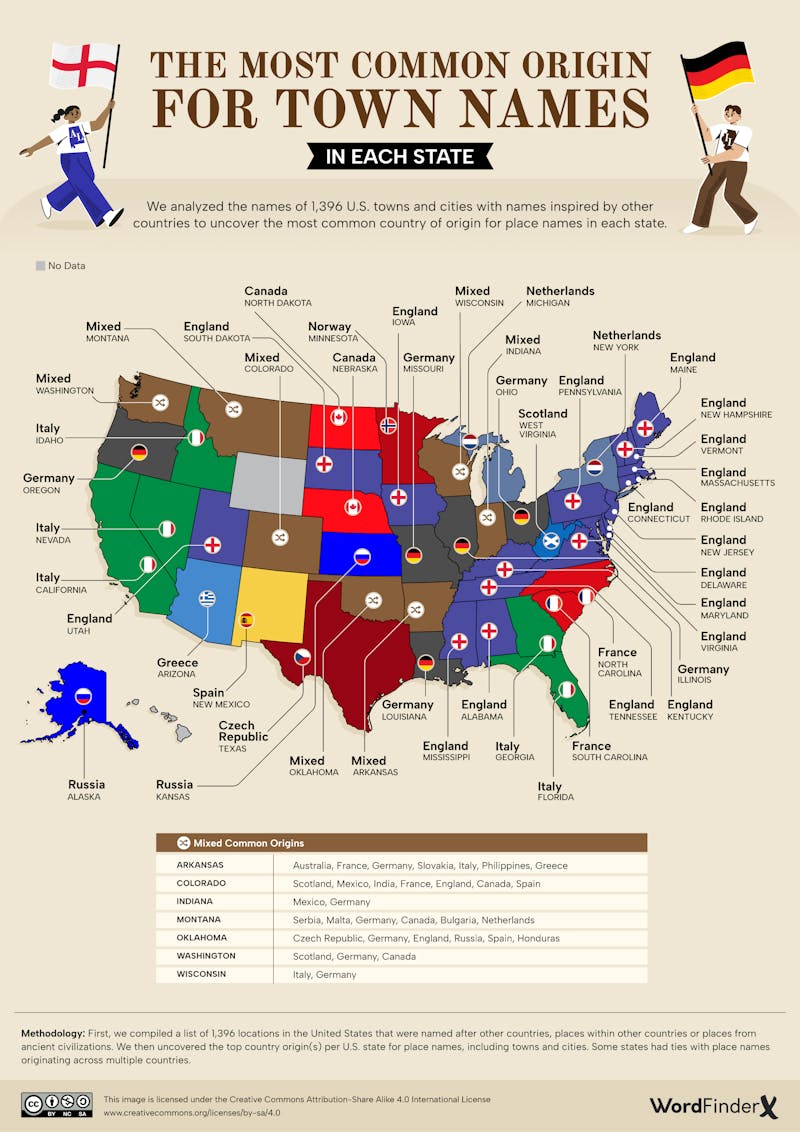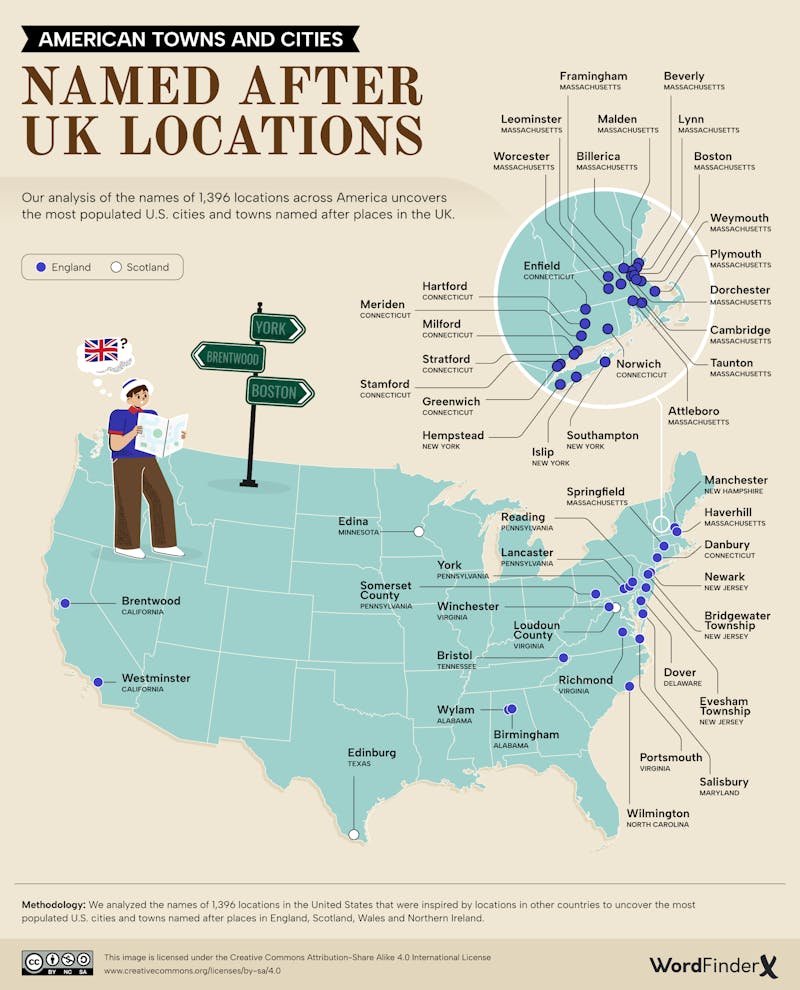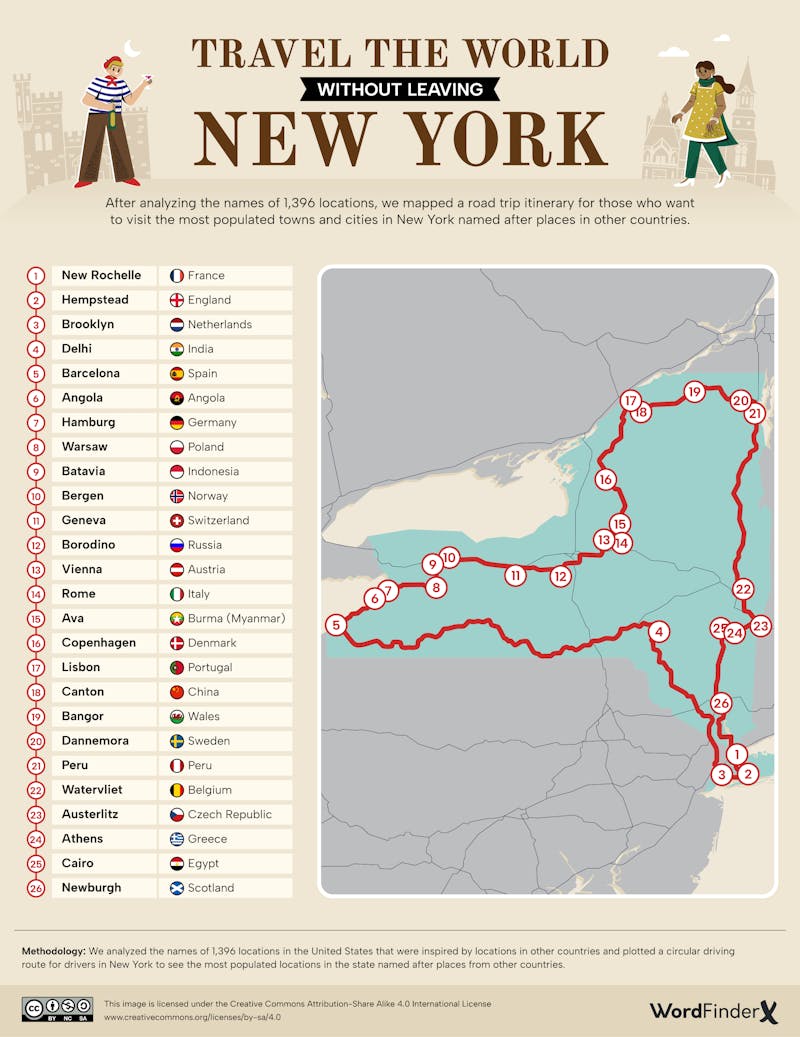The Global Origins of Town Names in Every State

Just like your favorite movie, if you really, really love your hometown, you may have mixed feelings about it getting a “sequel.” But that’s what happened across early America: Europeans colonized the land and named their settlements after the distant towns from whence they came.
Centuries on, while China builds brick-for-brick ‘re-makes’ of iconic international cities, America’s sequel towns have grown into very different places from the towns that inspired them. Still, it’s possible to get a flavor of the originals — whether European or otherwise — without leaving the States: the tulip festival in Holland, Michigan, or the ‘wild’ Swedish Dala horses of Lindsborg, Kansas, for example.
Inspired by this project by the team at Axios, data analysts at Word Finder X identified the most common countries of origin of American place names. Keep scrolling for a series of maps taking you through our findings, including unique road trips through California and New York to help you find your way around America’s own “little Europe.”
About This Study
We identified 1,396 locations in the U.S. named after foreign or ancient places. Then, we analyzed this data to uncover the most common country origin(s) used to name towns and cities in each state. We also discovered the most populated locations across America named after UK places. Finally, we plotted a driving route for the states of New York and California to take drivers through the most populated locations named after places from other countries.
The Most Common Country Origin for Place Names in Each State
We found 18 states where England is the most common country of origin of the place names. Germany is the second most honored country, as the most common place of origin of the town names in seven states, including Wisconsin. While the Berlin in Michigan changed its name to Marne following World War I, the Berliners of Wisconsin chose instead to change how their city was pronounced from the German Ber-lin to the more American Ber-lin, emphasizing the first syllable.
There are six states with a unique main source of place name: Texas (Czech Republic), Arizona (Greece), Indiana (Mexico), Minnesota (Norway), West Virginia (Scotland) and New Mexico (Spain). They are the only states to match with each of those countries. The Norwegian settler Osmund Osmundson homesteaded the site of Nedstrand, Minnesota, in 1856 and named it after his hometown. Today, the Minnesotan Nedstrand has almost exactly the same population (273) as Nedstrand, Norway (234).
The American Towns and Cities Named After UK Locations
English colonists often named their towns out of homesickness, pride or the hope of securing investment from flattered local aristocrats back home. Despite things ending rather badly between American patriots and the British Empire, many of the names stuck.
Some have far outgrown the towns that inspired them. Boston, MA (population: 650,000), is the largest city in New England, while Boston, Lincolnshire (population: 70,500), remains a minor port town of old England. Ironically, given the new Boston’s place in British colonial history, the ‘original’ Boston was once reported to have a higher proportion of European immigrants than anywhere else in England and Wales.
Greenwich, Connecticut, is one of America’s older English-named towns. At the time it was named (around 1640), the English Greenwich was in Kent (it has since been absorbed into London) and was particularly noted for its royal connections, including a palace recently remodeled by James I and its park, which remains London’s oldest Royal Park today. The naming of Greenwich, Connecticut, and the East Greenwiches in New Jersey, New York and Rhode Island, referenced the UK site’s symbolic status as an example of how land in England and foreign colonies ultimately belonged to the reigning monarch.
A Roadtrip to Travel the World Without Leaving California
A ‘global’ road trip around California means visiting places named after far-flung towns from Slovenia, Saudi Arabia, South Africa, Switzerland and more. And it begins with a real-life Fallout experience in a ghost town: New Idria is a mining town named after an Austrian quicksilver mine (now in Slovenia) in 1854; the California version was shut down and evacuated in 1972 due to water contamination. A trip to the UNESCO heritage site of Idria (now Idrija) in Slovenia is altogether more wholesome!
Idria is not the only ghost town on your route. Timbuctoo may have been named by an African-American miner from Timbuktu, Mali, although it’s possible that residents named it after their imaginative idea of a distant place that was rich in gold. The town fell into decline when one of the first environmental acts in the U.S. put a stop to the hydraulic gold mining by which the town was making its wealth.
There’s hardly a thing to see in Timbuctoo today. You might prefer to hasten on towards your final destination, Interlaken, which — with its many idyllic lakes — more closely resembles its foreign namesake in the Swiss Alps.
A Roadtrip to Travel the World Without Leaving the State of New York
Our New York road trip of foreign place names takes you from France to Scotland by way of India, Angola and Peru. The latter area was settled by English Quakers who believed the surrounding Adirondack Mountains resembled the Peruvian Andes. Angola, New York, was named by a group of Quakers who had done missionary work in the Portuguese colony of Angola, Africa.
One of New York’s most famous borrowed names takes us back to Europe. Brooklyn was one of several Dutch Long Island villages and was named after the Dutch village of Breukelen, from which many settlers arrived. The word means “broken land.” You can still find a trace of that Dutch heritage in the street names and the architecture of places like Old Stone House in Park Slope and the Wyckoff Farmhouse Museum.
Did You Ever Go to Paris?
The U.S. is a young country on ancient land, and as the increasingly common land acknowledgments reinforce, the history of America is very much a palimpsest. From their literal meaning to their geographic roots, American place names are rarely as simple as they seem, and each sits upon a trove of personal, regional and international cultural baggage that can be as emotional and as educationally valuable as they are downright fascinating.
Methodology
We compiled a list of 1,396 locations in the United States that were named after other countries, places within other countries or places from ancient civilizations.
We then uncovered the most common country origin(s) per U.S. state for place names, including towns and cities. We also found the most populated U.S. locations named after UK locations.
Finally, we plotted a circular driving route for the states of New York and California that enabled drivers to see the most populated locations named after places from other countries.
The data was collected and analyzed in April 2024.



